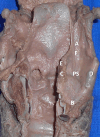Morphometry of the thyroid cartilage, epiglottis and piriform sinus: An anatomical study
- PMID: 39015142
- PMCID: PMC11249526
- DOI: 10.12688/f1000research.144481.2
Morphometry of the thyroid cartilage, epiglottis and piriform sinus: An anatomical study
Abstract
Background: The goal was to measure the piriform sinus, epiglottis, and thyroid cartilage in our sample population.
Methods: This study included 22 adult embalmed cadavers available in the Department of Anatomy. Dimensions were measured using a digital Vernier caliper.
Results: The mean height of the thyroid laminae was 27 ± 1.4 mm at the right side and 25.5 ± 1.4 mm at the left side. Mean width of the thyroid lamina was 27.1 ± 1.3 mm at the right side and 27.4 ± 0.9 mm at the left side. The mean thickness of thyroid cartilage was found to be 4.4 ± 0.4 mm and 3.9 ± 0.5 mm over the right and left sides. The mean length, width and thickness of the epiglottis were 29.1 ± 0.5 mm, 22.2 ± 0.6 mm and 2.6 ± 0.3 mm correspondingly. The height, width and thickness of the right piriform sinus were 25 ± 0.5 mm, 14.2 ± 0.5 mm and 12.6 ± 0.5 mm, the same parameters were 25.3 ± 1.3 mm, 15.1 ± 0.7 mm and 13.3 ± 0.4 mm for the left side.
Conclusions: The height and thickness of the thyroid cartilage were greater on the right side than on the left side (p<0.05). It was statistically observed that the width and thickness were greater on the left side than on the right side (p < 0.05). The data about the height, width and thickness of the thyroid cartilage, epiglottis and piriform sinus are essential during the laryngeal and other neck surgeries. They guide in the preoperative positioning, predicting the difficulty of intraoperative exposure and retractor pulling.
Keywords: endoscopy; morphometry; otorhinolaryngology; piriform sinus.
Copyright: © 2024 Vadgaonkar R et al.
Conflict of interest statement
No competing interests were disclosed.
Figures



References
-
- Anson BJ, McVay CB: Surgical Anatomy. 5th ed. WB Saunders;1971;255.
-
- Adamiec E, Dzięciołowska-Baran E, Czerwiński F, et al. : Prenatal development of the human trachea. Folia Morphol. (Warsz). 2002;61(2):123–125. - PubMed
MeSH terms
Associated data
LinkOut - more resources
Full Text Sources

